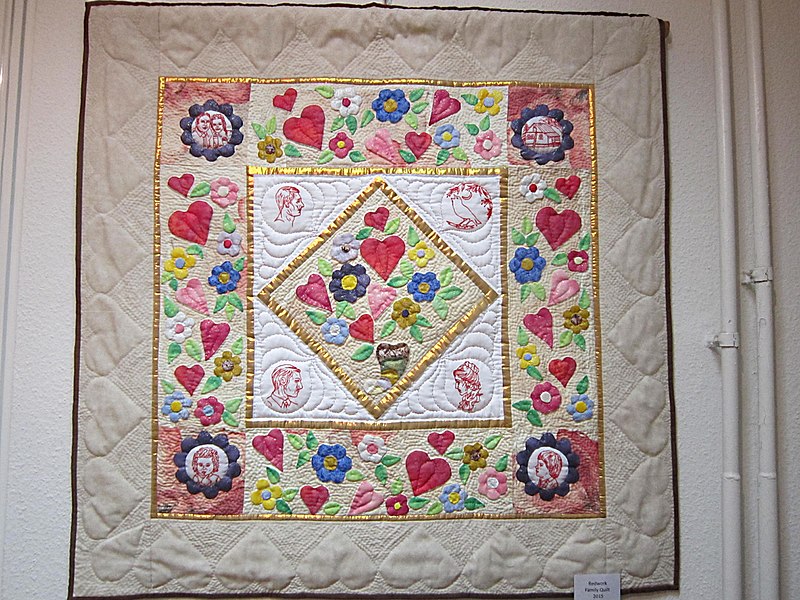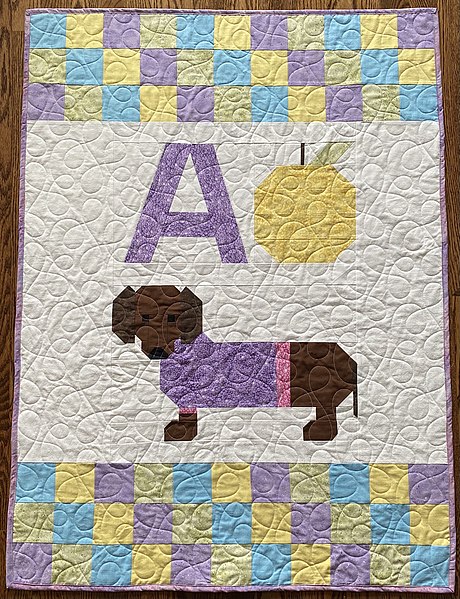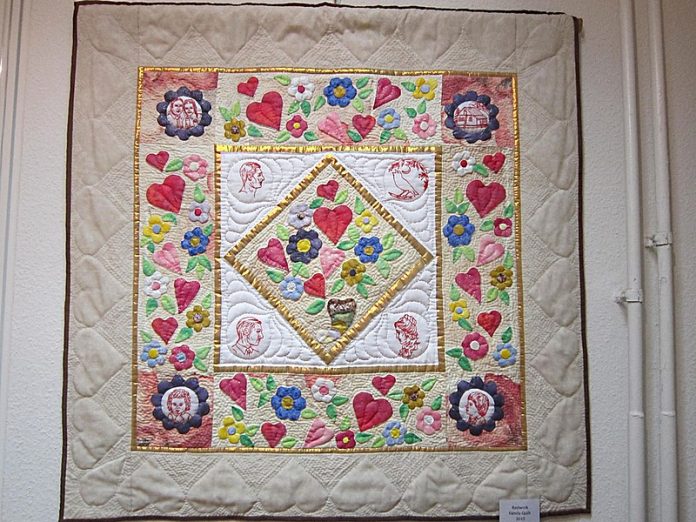Appliqué is a basic quilting technique that involves cutting and sewing fabric pieces of diverse designs, sizes, and shapes onto a background material. It’s simple to learn and once mastered, it opens up a world of creative quilt-making possibilities. When making an appliqué, you must keep a stitching order in connecting pieces. If you are doing a butterfly, for example, stitch the wings first, then the body. What you need to watch out for are puckered background and uneven stitches.

Appliqué Quilting: How To Do It
The word appliqué comes from the French word appliquer, which means “to put on.” It is a basic quilting technique that entails cutting and sewing fabric pieces of various designs, sizes, and shapes onto a background material.
Appliqué quilting allows a quilter’s artistic potential to shine through, resulting in stunning pictographic quilts. However, some quilters believe that appliquéing is a difficult technique that should only be attempted by master quilters.
They’re terrified to try their hand at it. The truth is that appliquéing isn’t nearly as difficult as many people believe. It’s simple to learn and once mastered, it opens up a world of creative quilting possibilities.
How do you precisely make appliqués? Here’s how:
1. Create a design pattern that you want to make. You can do this by tracing the style you desire on to a freezer paper utilizing a marker. Keep in mind that you have to draw the reverse side of the style. Do not include a seam allowance.
2. Place the glossy side of the cut-out freezer paper on the incorrect side of the material. Do not move the iron over the freezer paper. Keep in mind that the freezer paper will adhere to the material, however, it can be peeled off quickly.
3. Cut the fabric in the pattern of the freezer paper. Make a seam allowance of about 1/8 to 1/4 inch. Then fold the seam allowance over the pattern’s edges. When working with curves, you must notch the allowance all the way around to create smooth, rounded curves. Again, press the seam allowance. After that, peel away the freezer paper.

If you are doing a butterfly , very first sew the wings, then follow it with the body. You have to keep a sewing order in connecting pieces.
4. Begin attaching the appliqué pieces to the background fabric with a sewing machine. Remember to sew the larger pieces first, then lay and stitch the smaller pieces on top. If you’re making a butterfly appliqué, for example, stitch the wings first, then the body. When attaching appliqué pieces, you must keep a stitching order.
5. Make a series of small stitches. Small stitches, whether done by hand or machine, are important for appliqué because they are stronger and less visible in the quilt. In appliqués, you can use a variety of stitches, but the most common is blind stitch. You can do zigzag stitch, satin stitch, and other stitches with a machine.
6. When it comes to curves, be cautious. When hand-sewing, approaching curves is relatively simple. When using a machine, however, it can be a major concern. Reduce your speed, make a few stitches, then put the needle down and slightly reposition the fabric to achieve perfect machine-stitched curves. This will prevent gaps between stitches. As you get closer to tighter curves, make fewer stitches and do more fabric repositioning.
It’s possible that your first attempt at appliqué quilting will not yield the results you want. But don’t be discouraged; instead, use this as motivation to improve your appliqué skills each time.
It’s a good idea to get a few scraps and practice your stitching before you start appliquéing. Puckering in the background, uneven stitches, and sloppy appliqué pieces are all things to look out for.
Disclaimer: Please note, we do not publish sponsored posts. However, our posts contain affiliate links, where we may receive compensation for any purchases you make. This does not affect the price you pay. Thanks for trusting our site!


![5 Best Janome Sewing Machine for Quilting [Complete Buying Guide With Reviews] Best Janome Sewing Machine for Quilting](https://quiltingtoolsreview.com/wp-content/uploads/2021/04/Best-Janome-Sewing-Machine-for-Quilting-218x150.png)
![5 Best Sewing Machine for Beginner Quilters [Reviews, Buying Guide, FAQs – All You Need to Start] Best Sewing Machine for Beginner Quilters](https://quiltingtoolsreview.com/wp-content/uploads/2021/04/Best-Sewing-Machine-for-Beginner-Quilters-218x150.png)
![5 Best Sewing Machine for Quilting and Embroidery [Reviews – Buying Guide – How to Care] Best Sewing Machine for Quilting and Embroidery](https://quiltingtoolsreview.com/wp-content/uploads/2021/04/Best-Sewing-Machine-for-Quilting-and-Embroidery-218x150.png)
![5 Best Large Throat Sewing Machines for Quilting [Reviews & Buying Guide] Best Large Throat Sewing Machine for Quilting](https://quiltingtoolsreview.com/wp-content/uploads/2021/04/Best-Large-Throat-Sewing-Machine-for-Quilting-218x150.png)


![Best Sewing Kits [For Sewers, Quilters, & Embroiderers] Best Sewing Kits [For Sewers, Quilters, & Embroiderers]](https://quiltingtoolsreview.com/wp-content/uploads/2020/07/Best-Sewing-Kits-For-Sewers-Quilters-Embroiderers-1-218x150.png)
![6 Best Machine Quilting Rulers [How to Choose or Use?] Best Machine Quilting Rulers](https://quiltingtoolsreview.com/wp-content/uploads/2020/07/Best-Machine-Quilting-Rulers-How-to-Use-Machine-Quilting-Rulers_-218x150.png)


![Designing the Perfect Quilting Space [How to Design the Perfect Quilting Studio?] Designing the Perfect Quilting Space [How to Design the Perfect Quilting Studio?]](https://quiltingtoolsreview.com/wp-content/uploads/2020/05/Designing-the-Perfect-Quilting-Space-How-to-Design-the-Perfect-Quilting-Studio-218x150.png)


![Best Quilting Books [Beginner to Advanced Quilters] Best Quilting Books](https://quiltingtoolsreview.com/wp-content/uploads/2018/12/Best-Quilting-Books-218x150.png)




![5 Best Janome Sewing Machine for Quilting [Complete Buying Guide With Reviews] Best Janome Sewing Machine for Quilting](https://quiltingtoolsreview.com/wp-content/uploads/2021/04/Best-Janome-Sewing-Machine-for-Quilting-100x70.png)
![5 Best Sewing Machine for Beginner Quilters [Reviews, Buying Guide, FAQs – All You Need to Start] Best Sewing Machine for Beginner Quilters](https://quiltingtoolsreview.com/wp-content/uploads/2021/04/Best-Sewing-Machine-for-Beginner-Quilters-100x70.png)
![Best Iron for Quilting [Buying Guide & Reviews]](https://quiltingtoolsreview.com/wp-content/uploads/2018/12/Best-Iron-for-Quilting-100x70.png)

![Best Quilting Marking Pens [Reviews & FAQs] Best Quilting Marking Pens](https://quiltingtoolsreview.com/wp-content/uploads/2019/01/Best-Quilting-Marking-Pens-100x70.png)




